fuel cap Alfa Romeo Giulia 2019 Owner's Manual
[x] Cancel search | Manufacturer: ALFA ROMEO, Model Year: 2019, Model line: Giulia, Model: Alfa Romeo Giulia 2019Pages: 232, PDF Size: 4.87 MB
Page 69 of 232
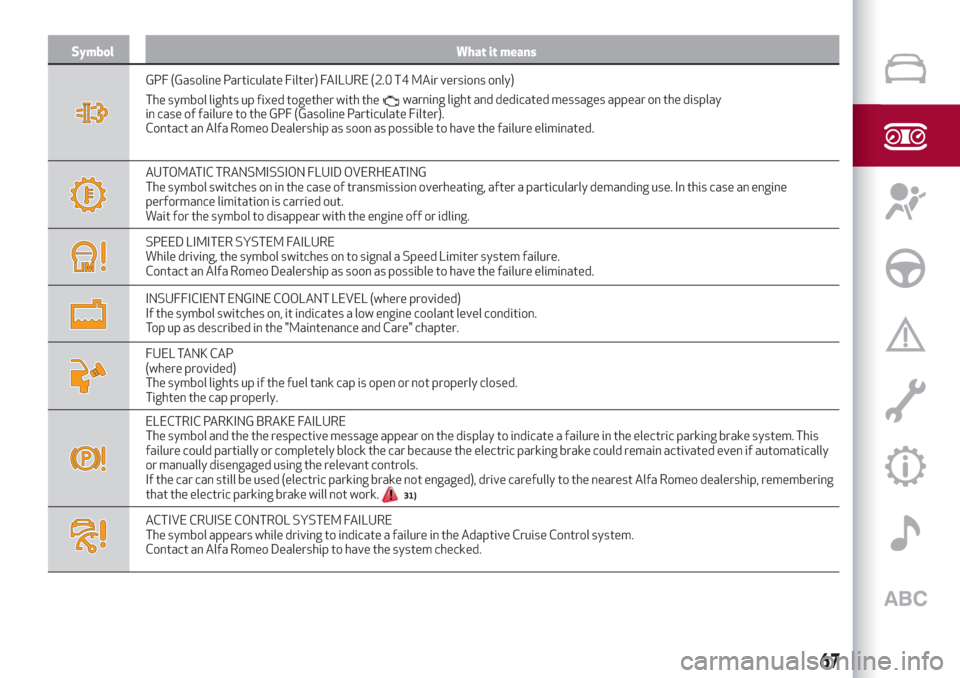
Symbol What it means
GPF (Gasoline Particulate Filter) FAILURE (2.0 T4 MAir versions only)
The symbol lights up fixed together with the
in case of failure to the GPF (Gasoline Particulate Filter).
Contact an Alfa Romeo Dealership as soon as possible to have the failure eliminated.
AUTOMATIC TRANSMISSION FLUID OVERHEATING
The symbol switches on in the case of transmission overheating, after a particularly demanding use. In this case an engine
performance limitation is carried out.
Wait for the symbol to disappear with the engine off or idling.
SPEED LIMITER SYSTEM FAILURE
While driving, the symbol switches on to signal a Speed Limiter system failure.
Contact an Alfa Romeo Dealership as soon as possible to have the failure eliminated.
INSUFFICIENT ENGINE COOLANT LEVEL (where provided)
If the symbol switches on, it indicates a low engine coolant level condition.
Top up as described in the "Maintenance and Care" chapter.
FUEL TANK CAP
(where provided)
The symbol lights up if the fuel tank cap is open or not properly closed.
Tighten the cap properly.
ELECTRIC PARKING BRAKE FAILURE
The symbol and the the respective message appear on the display to indicate a failure in the electric parking brake system. This
failure could partially or completely block the car because the electric parking brake could remain activated even if automatically
or manually disengaged using the relevant controls.
If the car can still be used (electric parking brake not engaged), drive carefully to the nearest Alfa Romeo dealership, remembering
that the electric parking brake will not work.
31)
ACTIVE CRUISE CONTROL SYSTEM FAILURE
The symbol appears while driving to indicate a failure in the Adaptive Cruise Control system.
Contact an Alfa Romeo Dealership to have the system checked.
67
warning light and dedicated messages appear on the display
Page 135 of 232
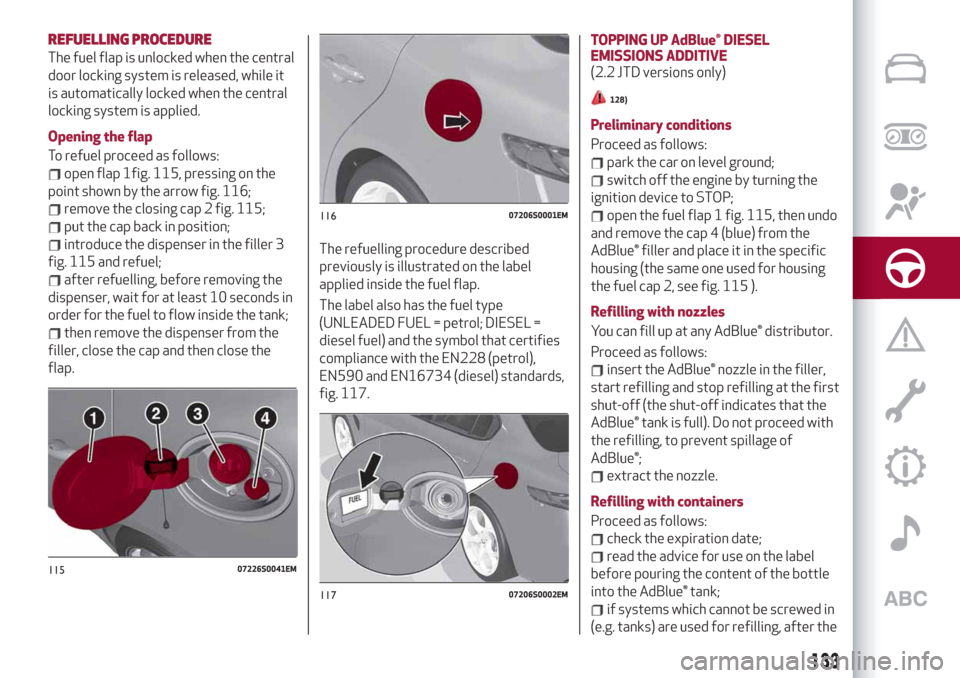
REFUELLING PROCEDURE
The fuel flap is unlocked when the central
door locking system is released, while it
is automatically locked when the central
locking system is applied.
Opening the flap
To refuel proceed as follows:
open flap 1fig. 115, pressing on the
point shown by the arrow fig. 116;
remove the closing cap 2 fig. 115;
put the cap back in position;
introduce the dispenser in the filler 3
fig. 115 and refuel;
after refuelling, before removing the
dispenser, wait for at least 10 seconds in
order for the fuel to flow inside the tank;
then remove the dispenser from the
filler, close the cap and then close the
flap.The refuelling procedure described
previously is illustrated on the label
applied inside the fuel flap.
The label also has the fuel type
(UNLEADED FUEL = petrol; DIESEL =
diesel fuel) and the symbol that certifies
compliance with the EN228 (petrol),
EN590 and EN16734 (diesel) standards,
fig. 117.TOPPING UP AdBlue® DIESEL
EMISSIONS ADDITIVE
(2.2 JTD versions only)
128)
Preliminary conditions
Proceed as follows:
park the car on level ground;
switch off the engine by turning the
ignition device to STOP;
open the fuel flap 1 fig. 115, then undo
and remove the cap 4 (blue) from the
AdBlue® filler and place it in the specific
housing (the same one used for housing
the fuel cap 2, see fig. 115 ).
Refilling with nozzles
You can fill up at any AdBlue® distributor.
Proceed as follows:
insert the AdBlue® nozzle in the filler,
start refilling and stop refilling at the first
shut-off (the shut-off indicates that the
AdBlue® tank is full). Do not proceed with
the refilling, to prevent spillage of
AdBlue®;
extract the nozzle.
Refilling with containers
Proceed as follows:
check the expiration date;
read the advice for use on the label
before pouring the content of the bottle
into the AdBlue® tank;
if systems which cannot be screwed in
(e.g. tanks) are used for refilling, after the
11507226S0041EM
11607206S0001EM
11707206S0002EM
133
Page 136 of 232
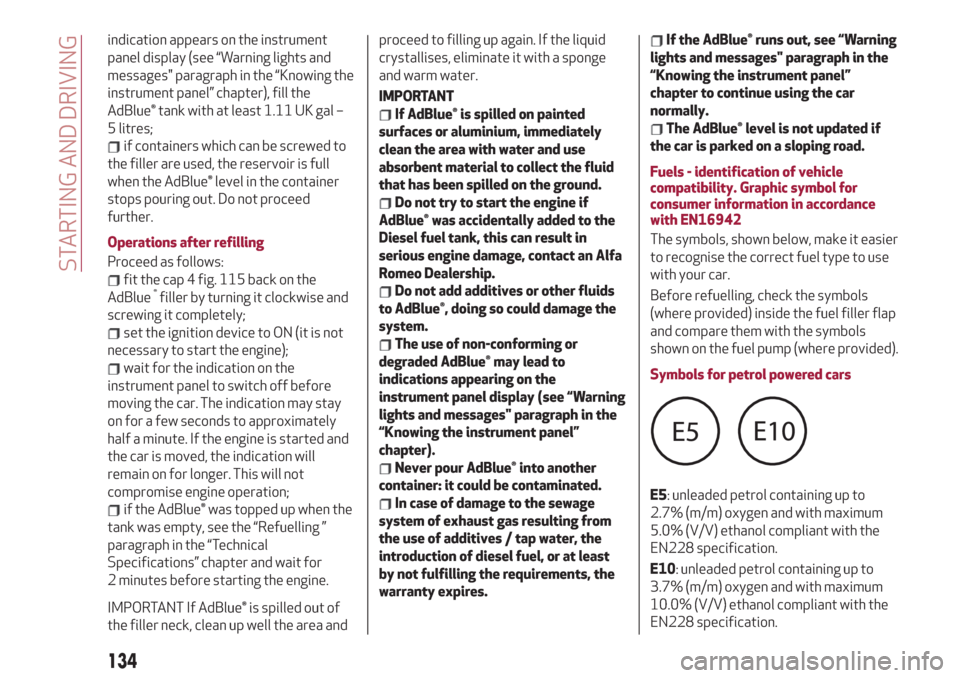
indication appears on the instrument
panel display (see “Warning lights and
messages" paragraph in the “Knowing the
instrument panel” chapter), fill the
AdBlue® tank with at least 1.11 UK gal –
5 litres;
if containers which can be screwed to
the filler are used, the reservoir is full
when the AdBlue® level in the container
stops pouring out. Do not proceed
further.
Operations after refilling
Proceed as follows:
fit the cap 4 fig. 115 back on the
AdBlue®filler by turning it clockwise and
screwing it completely;
set the ignition device to ON (it is not
necessary to start the engine);
wait for the indication on the
instrument panel to switch off before
moving the car. The indication may stay
on for a few seconds to approximately
half a minute. If the engine is started and
the car is moved, the indication will
remain on for longer. This will not
compromise engine operation;
if the AdBlue® was topped up when the
tank was empty, see the “Refuelling ”
paragraph in the “Technical
Specifications” chapter and wait for
2 minutes before starting the engine.
IMPORTANT If AdBlue® is spilled out of
the filler neck, clean up well the area andproceed to filling up again. If the liquid
crystallises, eliminate it with a sponge
and warm water.
IMPORTANT
If AdBlue® is spilled on painted
surfaces or aluminium, immediately
clean the area with water and use
absorbent material to collect the fluid
that has been spilled on the ground.
Do not try to start the engine if
AdBlue® was accidentally added to the
Diesel fuel tank, this can result in
serious engine damage, contact an Alfa
Romeo Dealership.
Do not add additives or other fluids
to AdBlue®, doing so could damage the
system.
The use of non-conforming or
degraded AdBlue® may lead to
indications appearing on the
instrument panel display (see “Warning
lights and messages" paragraph in the
“Knowing the instrument panel”
chapter).
Never pour AdBlue® into another
container: it could be contaminated.
In case of damage to the sewage
system of exhaust gas resulting from
the use of additives / tap water, the
introduction of diesel fuel, or at least
by not fulfilling the requirements, the
warranty expires.
If the AdBlue® runs out, see “Warning
lights and messages" paragraph in the
“Knowing the instrument panel”
chapter to continue using the car
normally.
The AdBlue® level is not updated if
the car is parked on a sloping road.
Fuels - identification of vehicle
compatibility. Graphic symbol for
consumer information in accordance
with EN16942
The symbols, shown below, make it easier
to recognise the correct fuel type to use
with your car.
Before refuelling, check the symbols
(where provided) inside the fuel filler flap
and compare them with the symbols
shown on the fuel pump (where provided).
Symbols for petrol powered cars
E5: unleaded petrol containing up to
2.7% (m/m) oxygen and with maximum
5.0% (V/V) ethanol compliant with the
EN228 specification.
E10: unleaded petrol containing up to
3.7% (m/m) oxygen and with maximum
10.0% (V/V) ethanol compliant with the
EN228 specification.
134
STARTING AND DRIVING
Page 137 of 232
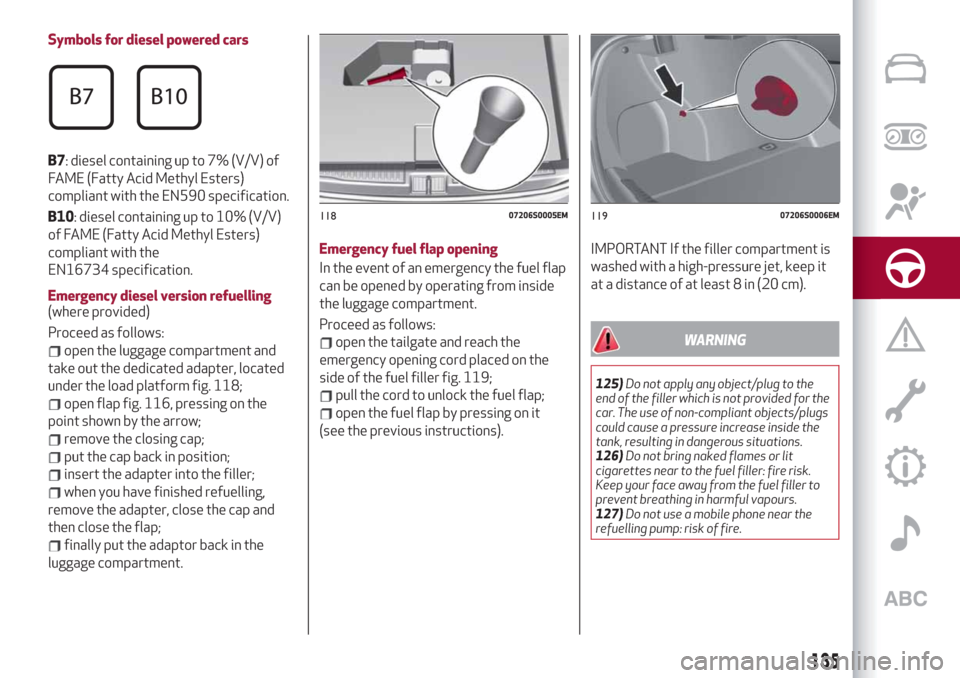
Symbols for diesel powered cars
B7: diesel containing up to 7% (V/V) of
FAME (Fatty Acid Methyl Esters)
compliant with the EN590 specification.
B10: diesel containing up to 10% (V/V)
of FAME (Fatty Acid Methyl Esters)
compliant with the
EN16734 specification.
Emergency diesel version refuelling
(where provided)
Proceed as follows:
open the luggage compartment and
take out the dedicated adapter, located
under the load platform fig. 118;
open flap fig. 116, pressing on the
point shown by the arrow;
remove the closing cap;
put the cap back in position;
insert the adapter into the filler;
when you have finished refuelling,
remove the adapter, close the cap and
then close the flap;
finally put the adaptor back in the
luggage compartment.Emergency fuel flap opening
In the event of an emergency the fuel flap
can be opened by operating from inside
the luggage compartment.
Proceed as follows:
open the tailgate and reach the
emergency opening cord placed on the
side of the fuel filler fig. 119;
pull the cord to unlock the fuel flap;
open the fuel flap by pressing on it
(see the previous instructions).
IMPORTANT If the filler compartment is
washed with a high-pressure jet, keep it
at a distance of at least 8 in (20 cm).
WARNING
125)Do not apply any object/plug to the
end of the filler which is not provided for the
car. The use of non-compliant objects/plugs
could cause a pressure increase inside the
tank, resulting in dangerous situations.
126)Do not bring naked flames or lit
cigarettes near to the fuel filler: fire risk.
Keep your face away from the fuel filler to
prevent breathing in harmful vapours.
127)Do not use a mobile phone near the
refuelling pump: risk of fire.
11807206S0005EM11907206S0006EM
135
Page 138 of 232
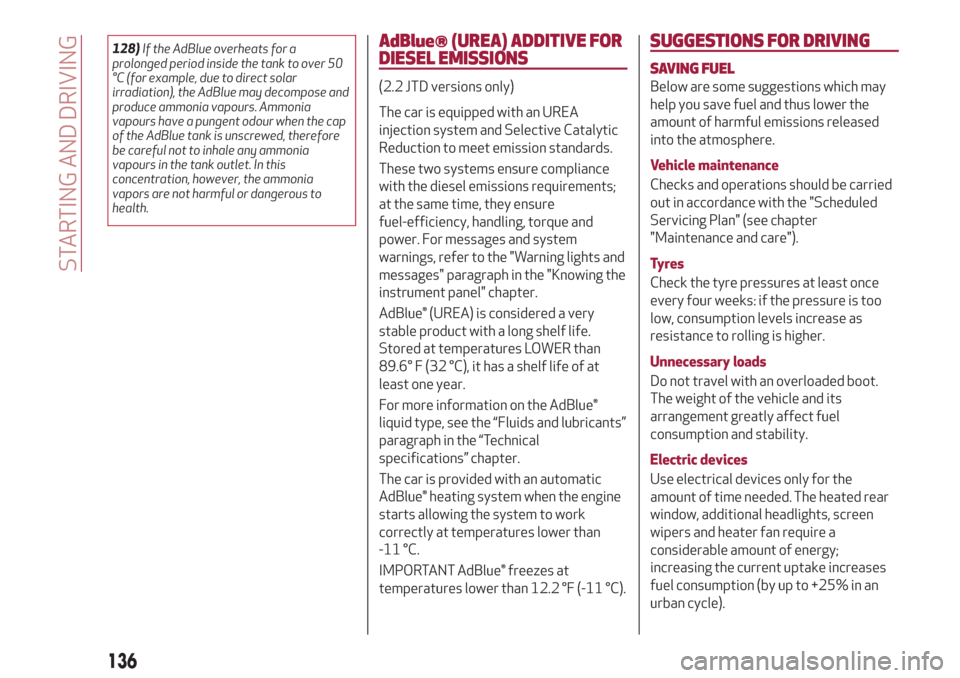
128)If the AdBlue overheats for a
prolonged period inside the tank to over 50
°C (for example, due to direct solar
irradiation), the AdBlue may decompose and
produce ammonia vapours. Ammonia
vapours have a pungent odour when the cap
of the AdBlue tank is unscrewed, therefore
be careful not to inhale any ammonia
vapours in the tank outlet. In this
concentration, however, the ammonia
vapors are not harmful or dangerous to
health.AdBlue® (UREA) ADDITIVE FOR
DIESEL EMISSIONS
(2.2 JTD versions only)
The car is equipped with an UREA
injection system and Selective Catalytic
Reduction to meet emission standards.
These two systems ensure compliance
with the diesel emissions requirements;
at the same time, they ensure
fuel-efficiency, handling, torque and
power. For messages and system
warnings, refer to the "Warning lights and
messages" paragraph in the "Knowing the
instrument panel" chapter.
AdBlue® (UREA) is considered a very
stable product with a long shelf life.
Stored at temperatures LOWER than
89.6° F (32 °C), it has a shelf life of at
least one year.
For more information on the AdBlue®
liquid type, see the “Fluids and lubricants”
paragraph in the “Technical
specifications” chapter.
The car is provided with an automatic
AdBlue® heating system when the engine
starts allowing the system to work
correctly at temperatures lower than
-11 °C.
IMPORTANT AdBlue® freezes at
temperatures lower than 12.2 °F (-11 °C).
SUGGESTIONS FOR DRIVING
SAVING FUEL
Below are some suggestions which may
help you save fuel and thus lower the
amount of harmful emissions released
into the atmosphere.
Vehicle maintenance
Checks and operations should be carried
out in accordance with the "Scheduled
Servicing Plan" (see chapter
"Maintenance and care").
Tyres
Check the tyre pressures at least once
every four weeks: if the pressure is too
low, consumption levels increase as
resistance to rolling is higher.
Unnecessary loads
Do not travel with an overloaded boot.
The weight of the vehicle and its
arrangement greatly affect fuel
consumption and stability.
Electric devices
Use electrical devices only for the
amount of time needed. The heated rear
window, additional headlights, screen
wipers and heater fan require a
considerable amount of energy;
increasing the current uptake increases
fuel consumption (by up to +25% in an
urban cycle).
136
STARTING AND DRIVING
Page 194 of 232
![Alfa Romeo Giulia 2019 Owners Manual REFUELLING
86) 87)
2.0 T4 MAir 2.2 JTDPrescribed fuels and original
lubricants
Fuel tank [UK gal (litres)] 12.76 (58) 11.4 (52)Unleaded petrol
(EN228 specifications)
(2.0 T4 MAir engine) / Automotive
Alfa Romeo Giulia 2019 Owners Manual REFUELLING
86) 87)
2.0 T4 MAir 2.2 JTDPrescribed fuels and original
lubricants
Fuel tank [UK gal (litres)] 12.76 (58) 11.4 (52)Unleaded petrol
(EN228 specifications)
(2.0 T4 MAir engine) / Automotive](/img/27/9392/w960_9392-193.png)
REFUELLING
86) 87)
2.0 T4 MAir 2.2 JTDPrescribed fuels and original
lubricants
Fuel tank [UK gal (litres)] 12.76 (58) 11.4 (52)Unleaded petrol
(EN228 specifications)
(2.0 T4 MAir engine) / Automotive
diesel fuel (EN590 and
EN16734 specifications)
(2.2 JTD engine) including a reserve of [UK gal
(litres)]1.98 (9.0) 1.76 (8.0)
AdBlue® tank (where provided)
capacity approximately [UK gal
(litres)]– 3.5 / 16.1AdBlue® (DIN 70 070 and ISO
22241-1 specifications)
(2.2 JTD engine)
Primary cooling system (versions
with manual transmission) [UK
gal (litres)]1.89 (8.6) 1.75 (8.0)
50% mixture of distilled water
and PARAFLU UP
(*)Primary cooling system (versions
with automatic transmission) [UK
gal (litres)]1.89 (8.6)1.92 (8.75) (136 HP/160 HP/
190 HP RWD engines) / 1.96 (8.9)
(190 HP/210 HP AWD engines)
Secondary cooling system [UK
gal (litres)]0.95 (4.3)1.16 (5.3) (190 HP/210 HP AWD
automatic transmission engines)
Engine oil filter [UK gal (litres)] 0.13 (0.6) 0.11 (0.5)SELENIA DIGITEK P.E.
(2.0 T4 MAir engine) / SELENIA
W.R. FORWARD 0W-20 (2.2 JTD
engine) (versions with AdBlue®) /
SELENIA W.R. FORWARD 0W-20
(2.2 JTD 150 HP / 180 HP
engines) (versions without
AdBlue®) / SELENIA W.R.
FORWARD 0W-30 (2.2 JTD
210 HP engines) (versions without
AdBlue®) Engine oil sump [UK gal (litres)] 1.01 (4.6)0.68 (3.1) (RWD versions) / 0.85
(3.9) (AWD versions)
(*) When the vehicle is used in particularly harsh weather conditions, we recommend using a 60% mixture of PARAFLU UP and 40% demineralised water.
192
TECHNICAL DATA